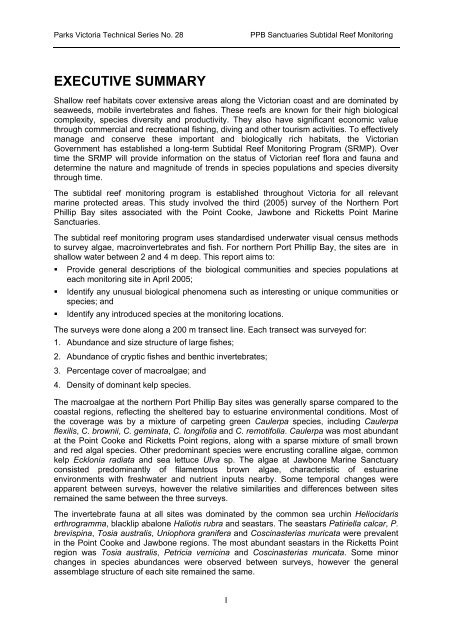Victorian Subtidal Reef Monitoring Program - Parks Victoria
Victorian Subtidal Reef Monitoring Program - Parks Victoria
Victorian Subtidal Reef Monitoring Program - Parks Victoria
Create successful ePaper yourself
Turn your PDF publications into a flip-book with our unique Google optimized e-Paper software.
<strong>Parks</strong> <strong>Victoria</strong> Technical Series No. 28PPB Sanctuaries <strong>Subtidal</strong> <strong>Reef</strong> <strong>Monitoring</strong>EXECUTIVE SUMMARYShallow reef habitats cover extensive areas along the <strong><strong>Victoria</strong>n</strong> coast and are dominated byseaweeds, mobile invertebrates and fishes. These reefs are known for their high biologicalcomplexity, species diversity and productivity. They also have significant economic valuethrough commercial and recreational fishing, diving and other tourism activities. To effectivelymanage and conserve these important and biologically rich habitats, the <strong><strong>Victoria</strong>n</strong>Government has established a long-term <strong>Subtidal</strong> <strong>Reef</strong> <strong>Monitoring</strong> <strong>Program</strong> (SRMP). Overtime the SRMP will provide information on the status of <strong><strong>Victoria</strong>n</strong> reef flora and fauna anddetermine the nature and magnitude of trends in species populations and species diversitythrough time.The subtidal reef monitoring program is established throughout <strong>Victoria</strong> for all relevantmarine protected areas. This study involved the third (2005) survey of the Northern PortPhillip Bay sites associated with the Point Cooke, Jawbone and Ricketts Point MarineSanctuaries.The subtidal reef monitoring program uses standardised underwater visual census methodsto survey algae, macroinvertebrates and fish. For northern Port Phillip Bay, the sites are inshallow water between 2 and 4 m deep. This report aims to:• Provide general descriptions of the biological communities and species populations ateach monitoring site in April 2005;• Identify any unusual biological phenomena such as interesting or unique communities orspecies; and• Identify any introduced species at the monitoring locations.The surveys were done along a 200 m transect line. Each transect was surveyed for:1. Abundance and size structure of large fishes;2. Abundance of cryptic fishes and benthic invertebrates;3. Percentage cover of macroalgae; and4. Density of dominant kelp species.The macroalgae at the northern Port Phillip Bay sites was generally sparse compared to thecoastal regions, reflecting the sheltered bay to estuarine environmental conditions. Most ofthe coverage was by a mixture of carpeting green Caulerpa species, including Caulerpaflexilis, C. brownii, C. geminata, C. longifolia and C. remotifolia. Caulerpa was most abundantat the Point Cooke and Ricketts Point regions, along with a sparse mixture of small brownand red algal species. Other predominant species were encrusting coralline algae, commonkelp Ecklonia radiata and sea lettuce Ulva sp. The algae at Jawbone Marine Sanctuaryconsisted predominantly of filamentous brown algae, characteristic of estuarineenvironments with freshwater and nutrient inputs nearby. Some temporal changes wereapparent between surveys, however the relative similarities and differences between sitesremained the same between the three surveys.The invertebrate fauna at all sites was dominated by the common sea urchin Heliocidariserthrogramma, blacklip abalone Haliotis rubra and seastars. The seastars Patiriella calcar, P.brevispina, Tosia australis, Uniophora granifera and Coscinasterias muricata were prevalentin the Point Cooke and Jawbone regions. The most abundant seastars in the Ricketts Pointregion was Tosia australis, Petricia vernicina and Coscinasterias muricata. Some minorchanges in species abundances were observed between surveys, however the generalassemblage structure of each site remained the same.I
















